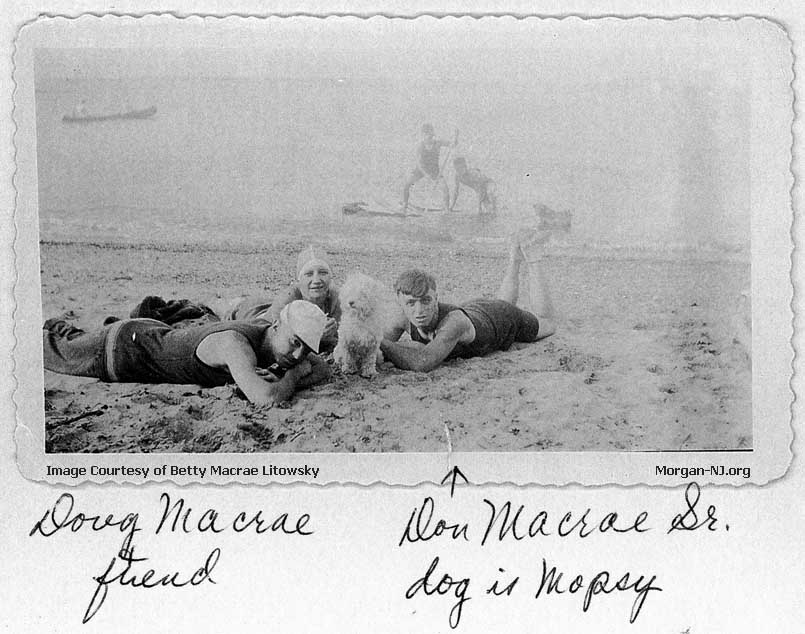
Doug Macrae, Friend, Mopsy, and Don Macrae, Sr. on Morgan Beach date unknown. Image courtesy of Betty Macrae Litowsky.
Morgan Memories – Betty Macrae Litowsky’s Reflections on Morgan Beach
This page is the consolidation of a collection of personal stories about Morgan Beach written by Betty Litowsky for her family. Betty and her sister Jeanne, the children of the iconic Robert E. Lee Inn owners Don and Ruth MacRae, grew up across the channel from Morgan Beach at the “Robert E. Lee” during World War II and its immediate post year years. Betty has been kind enough to allow for us to share her remembrances of growing up in that fondly remembered and uniquely Morgan building. Another page contains her Robert E. Lee Inn stories which can be read by clicking on this link. Thank you to Betty for sharing these wonderful stories!
There were about 25 bungalows on the actual beach. They were lined up in a long row and sat back about 100 feet in from the bay at low tide. Across from the bungalows, facing the highway, were a few stores. There was also “the stand” [her father’s hot dog stand] which was a small structure with a large deck with picnic tables and benches and an opening that patrons could walk up to order their hot dogs and snacks. It sat alone on the south side of the entrance to the parking area which was at the front of the bungalows. They could squeeze in a lot of cars into that rather small area but, of course, there were the traffic guys with their police whistles hanging around their necks always wildly waving their arms and pointing to some space where just one more car might fit in. These traffic men were civilians and were paid by the state to keep the traffic moving. The lanyards around their necks, I think, were like status symbols showing that they were a part of the civilian patrol. They were the same guys that wore the white helmets with the insignias on the front when they warned about the air raids at night and banged on the door if the blackout shades were not pulled down far enough. My grandmother’s brother, “Uncle Bill” was one of them.
At the north side of the entrance was Demicelli’s. This was a regular store. Name it – he had it (like one of our modern day Stop ‘n Shop). He had the best hand-scooped ice cream – all flavors. He also had what Grandpa called “numbers.” This was something that only grown-ups knew about and at the time I didn’t care.
Just north of Demicelli’s was Kaisers. It was a bar. It was just across the channel from the Robert E. Lee and if you were facing the channel in either place, you were looking at the other. Kaiser’s was different, it was more of a fisherman’s hangout where a group of locals were to be found at any given time and it wasn’t unusual for customers who knew each other to yell hello across the water.
The channel was dangerous in many ways, there were motorboats coming and going all the time and the undertow that was created by deep water that was channeled from one body of water to another created a treacherous current when the tide was coming in or going out. It was a rare weekend when there was not at least one near fatality. I saw many people drown, from little children to experienced swimmers. One, in particular, was a friend of my grandmother’s. He was calling to her [she was across the channel at the Robert E. Lee Inn] from the deck of Kaiser’s. She couldn’t hear him. He dove in from the deck and began to swim across but the current pulled him under. He was floating out at the lighthouse by the time they got to him. Most of the time the people involved were from the city that did not read the warnings to not to swim in the channel. There were many drownings at the spot in the years I lived there.
There were lots of car accidents, too. Again, it would be an unusual weekend without the familiar sound of a crash, usually a bumper banger, because of the kind of stop and go traffic that was on the narrow two-lane highway. Starting at dawn on a Saturday or Sunday, it was always bumper to bumper. If the state troopers were called, they had to use the shoulders of the road with their motorcycles (which is what they used in South Jersey). There are so many stories about the area around the Morgan Creek, I don’t think I have the time or space to tell them all. I will try though.
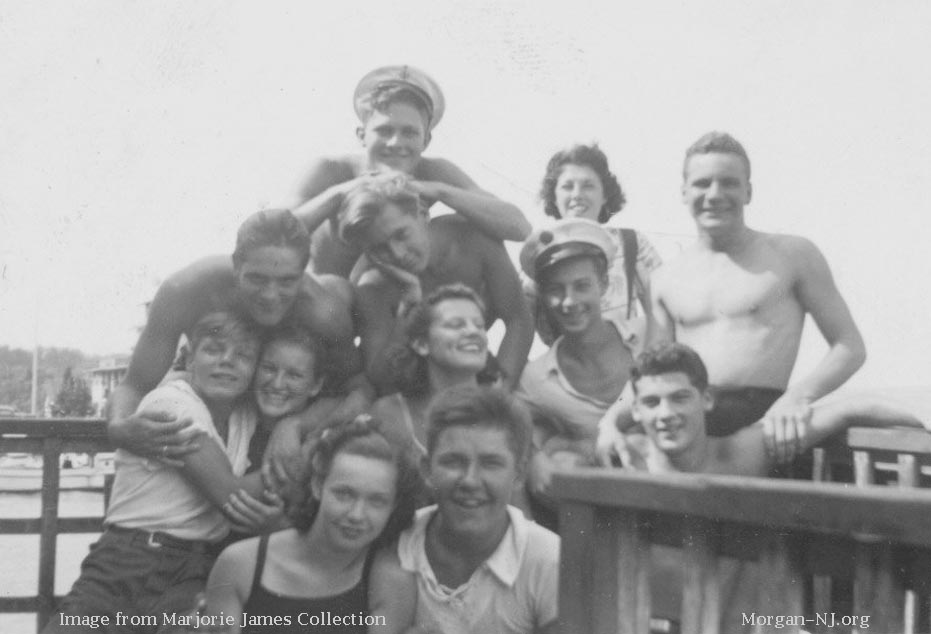
Bette Adams, Billy Martins, Merrith ?, Harold Guscott, Juanita ?, Dorothy Thalmann, Bill ?, Jimmey Hess, Bob Smalley, Edgar Search, Eddie Kaestner, and Fluff Muth on Morgan Beach circa 1938. Image courtesy of Marjorie James.
The Morgan Beach crowd of the 40’s was of a group of about 30 young people that ranged in age from 12 or 13 up to the early 20’s the nucleus of which was a tight-knit group of 8 or 10. The rest were friends of friends who dropped by often but the smaller group were always there rain or shine. On rainy days they would play games under the awnings or in Uncle Bill’s garage [on the beach], which was set up like a playroom. The perimeter of the room was painted with cartoon characters and there were card tables and folding chairs three deep lined up against the walls. The men called it the “Limburger” club because that is where the men played cards, smoked cigars, and had Limburger sandwiches (a precursor to the man cave). Two doors down from Uncle Bill lived Mrs. Gross. She had white hair, walked with a cane, and had the world’s meanest (and ugliest) dog. She kept him on a chain which was bolted into the cement of her front stoop. He was a Bulldog and wanted nothing more than to break away and bite you! My grandmother said that because she was a widow and lived alone he made her feel safe.
On Friday evenings in the summer, my grandmother’s sister, Auntie Anna would come down from Newark to Morgan and she would have with her my pretty cousin, Honey. Honey was about 12 in 1942 (I was 5) so for her to play with me and talk to me like I was her peer was one of the thrills of my childhood! I thought she was the prettiest of all the young girls and women that came to eat dinner or come to listen to the music and dance. She had long dark hair and big brown eyes and she had the nicest clothes! She wore suits when she “worked” the check room, and on the beach or in the daytime. She wore the stylish shorts of the day with a sort of bib front with shoulder straps and a white peasant blouse underneath. Wow! To me, she looked like a movie star with her deep tan and the Mexican sandals. She was the only person I ever knew who really thought she could make the sunshine. She was a small girl and when she went to Morgan Beach where her “boyfriend’s’ family stayed for the summer to escape the heat of Union City, she looked tiny next to him. His family called him “Sonny” so that is what he was known as. They were “Honey and Sonny” from the beach. They got married in 1949 when I was 11 and to this day I don’t I have ever seen a lovelier bride. I am grateful for the time she spent with me, allowing me to go places and do things I would never have been allowed to do without her. She never made me feel like a tag-along or a bother to her (which I am sure many times I was).
We called all of our parents’ friends, “aunt” or “uncle.” Some of them were very close to the family and therefore were thought of as relatives. One of those “aunts” was Aunt Frances. She and Uncle Paulie lived in Union City, where most people had that Brooklyn accent. I loved to hear her talk and she had many unusual peccadillos, one of which was that she could not stand to touch a cotton ball or anything soft and fluffy. This would not have caused her much of a problem under ordinary circumstances, but she worked in a beauty parlor. She would relate how touching the cotton caused her to squirm when she had any contact with it. Well, it was really funny.
She and Uncle Paulie had a place on Morgan Beach – they lived right next to Mrs. Gross the old lady with the ugly vicious dog. We loved to go visit when they came down for the weekend. One time when I was about four or so, I was invited to stay with them overnight. I was so excited. I packed my pajamas and clean clothes for the nest day in a little satchel that had been Grandpa’s. When we got to Aunt Frances’ house she made some Franco American macaroni and cheese (it’s not on the market anymore but it was good). I was in my glory!
After I was put to bed, I just couldn’t get to sleep so I began to investigate the bedroom. In the night table next to the bed were some interesting things. A book, some matches (everyone smoked in 1942) and what looked like a small Hershey bar. Little chocolate squares. I took off the wrapper and broke off one of the pieces. I took a bite. It was not a Hershey bar! I took another bite. It was not a sweet, it tasted kind of funny but I kept eating it. I guess I was making noise because in came my Aunt Frances. “What are you eating?” “Nothing, I said.” “What do you have behind your back?” I was caught! I put the candy out on the bed, and as soon as I did, she gasped, “Oh my god!” I thought “uh oh, this is not good.” “That’s Ex-Lax! I have to call your mother.”
I could not figure out why all the commotion? I found out soon enough and spent most of the night in the bathroom. Every time I would get settled into bed, I would have to get up again. I was glad this all happened at Aunt Frances’ house she was really a good sport and made a joke of it all. For years she teased me about it and the “Ex-Lax fiasco,” as my father called it, was a way to tease me for years to come.
There was a phenomenon that took place every year, thousands of dead moss bunkers would wash up on the beach. I don’t know exactly what caused this, but it was something natural (not poison or sickness). In any event, it would happen at high tide and usually all in one day. The smell would knock your socks off! I always wanted to know what would cause all those fish to die in one day (I must look it up sometime). It took the beach tenders days to get it all cleared away. It was at the end of the season and right after that were the horseshoe crabs. They are so strange and their “blood” is blue. Sometimes, just to show the unbeliever, one of the “bad boys” would crush one to prove it. They came up on the beach in droves when it was time to lay their eggs in the warm sand. The females were really big, and they laid thousands of eggs. When those little things came out of the sand they were only as big as a bug, but they were an exact replica of their parents except they were transparent. The beach would be covered with them. I read somewhere they can live to 40 years or more.
It was a living science lesson being on Morgan Beach. There were eels, stone crabs (which were delicious if you boiled them – they would actually “scream” when they hit the hot water), then there were the famous Morgan clams. Everywhere in the stretching sandbar were the different variety of clams! There were the big gray round ones they ate on the half shell and there were the narrow black ones called muscles. Those could be steamed. All this for the taking and in abundance!
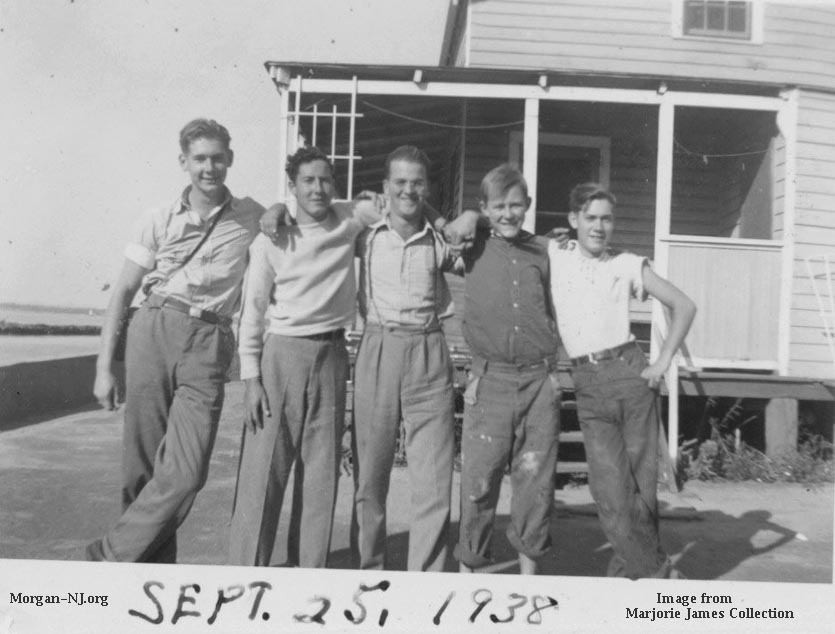
Edgar Search, Bill Holden, Jimmey Thetford, ‘Brush-head’ Vroome, and Carl Search in front of “Hock’s Pavilion” on Morgan Beach on September 25, 1935. Image courtesy of Marjorie James.
People paid kids to gather them in buckets to be sold to the restaurants nearby and to the markets in nearby towns. My sister and I were experts in finding the black ones – just look down at the smooth packed mud of the sandbar when the tide was out, where there were small round “air holes.” Dig in with your toes and unearth your prize! Even a small child could collect a dozen clams in a few minutes!
There were all manner of creatures in the bay, including jellyfish; they too came at their special time. They could be as small as the size of a quarter, or very large with slimed squishy tentacles that floated all around them. If you touched one, the sting was very painful. If you were unlucky enough to get wrapped up in them, you were a hospital case. They left large, angry red marks where it touched and stung and itched for days. We called them the big ones, “man ‘o wars,” they looked like atomic bombs floating on the water. Since they were basically translucent, you had to look carefully or one could float right into you! Oh yes, living with nature can be dangerous but you learned quickly.
New Jersey is known for its mosquitos. People used to tease it was the “state bird” – they were so BIG! At night, when they would come “out to play,” the men would light rags soaked in kerosene to keep them from landing on us. They would tie them to long sticks which were punched down into the sand. Those sticks were made to form a large circle and would all sit in the middle. While the smell of kerosene and citronella candles filled the air, the feeling of camaraderie was palpable. I loved those nights!
Usually, the men told stories of the day that had just passed. It was the busiest day they had seen since the 4th of July two years ago. They began turning cars away before 10 am in the morning because the lots were full of the people who let their children wander over to the “bulkhead” (that was the cement wall that was stacked with boulders so the channel didn’t flood the beach at high tide), or the near drowning when those city boys were jumping off the pilings, or the Gypsies who wanted to put up their tent right on the beach. At 11 o’clock, the beach was cleared and only one section could be used for bonfires or cookouts. They began blowing those whistles and clearing everyone off until dawn the following day. The excitement started all over again, before the sun was up, when they would be raking the beach in unison with those gigantic wooden rakes until it looked pristine for the start of a new day.
I slept on the beach facing the water, and if there was a full moon, it would shine into the open windows and the reflection on the bay make it seem almost like daytime. I was never a good sleeper, and after an action-filled day, the excitement kept my mind working overtime and that’s when I did my planning. I wanted to be a grown-up. I loved my life but I always wished I could live it as an adult. On my way to sleep, I thought of how much I wanted to BE the girl dancing to the Glen Miller tune, not watching from my hiding place under the baby grand with silk tassels hanging in front of my eyes.
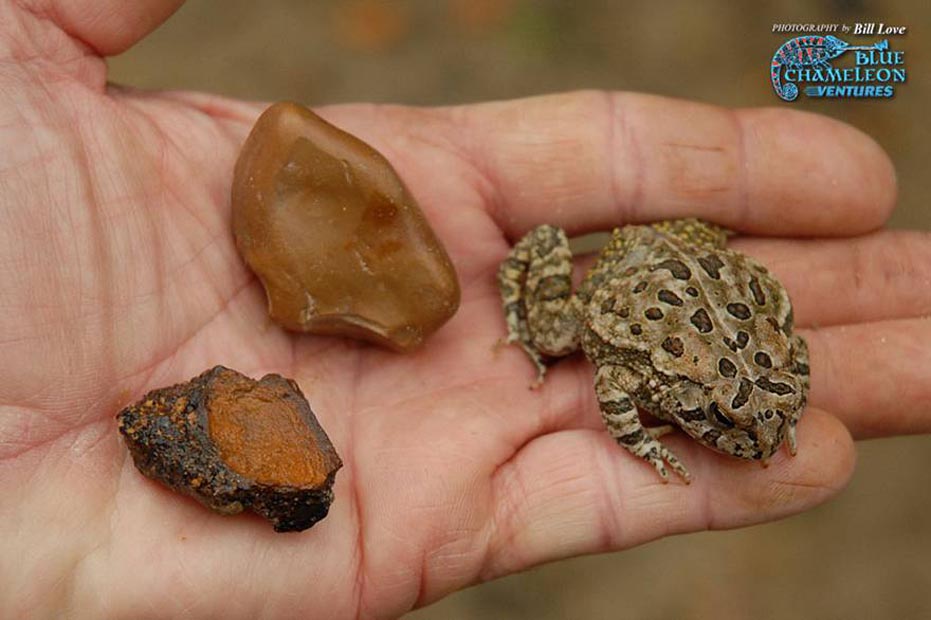
“Lucky Stone” (middle), “Indian Paint Pot” (left), and Toad from Morgan, NJ. Image courtesy of Bill Love – BlueChameleon.org.
I haven’t told you about the “lucky stones”. They were peculiar to Morgan Beach. They were small caramel colored pebbles that were very smooth and shiny. There seemed to be an endless supply of them. No matter how many were taken away as souvenirs by children year after year, there were thousands more to take their place. They seem to be formed by the clay-like stuff that was under the sandbars. Since the largest brickworks in the country was very nearby, I’m thinking it was the same kind of material that was in the earth over in Sayreville at the Sayre Fischer Brick Company (“Pop Pop” Fischer was Patti Gerity’s grandfather by way of Aunt Belle’s mother marrying him).
There were lots of other treasures to be found on the beach which my grandfather seemed to know about. I’m not sure where he learned everything about nature, but he was a fountain of knowledge about plants, trees, birds and just about anything we found on the beach; Shells of any kind, no matter what the size or shape. He was one of the most patient men I have ever met. He never seemed to get flustered. He was what people today call, “laid back”. In any event, he was an excellent source of information. He also knew how to “live off the land.” He would go out and pick dandelion greens, wash them in cold water and with a little vinegar, he had his salad to go with the fish he just caught, and boned, then fried in the big black iron frying pan. Even though he had fish for breakfast, there was no smell of fish, just the luscious fragrance of the toasted Kaiser roll he was holding over the gas flame of the giant eight-burner stove in the chef’s kitchen. If I wandered away from the kitchen, he’d call out, “Where’s my breakfast Buddy?” and put my breakfast out on the table. Most days I would have “eggs in a cup” (It is still one of my favorites, hard boiled eggs mashed down into a cup with butter and salt no pepper). V8 was our breakfast drink of choice. He said we didn’t need a vitamin pill if we had V8 in the morning.
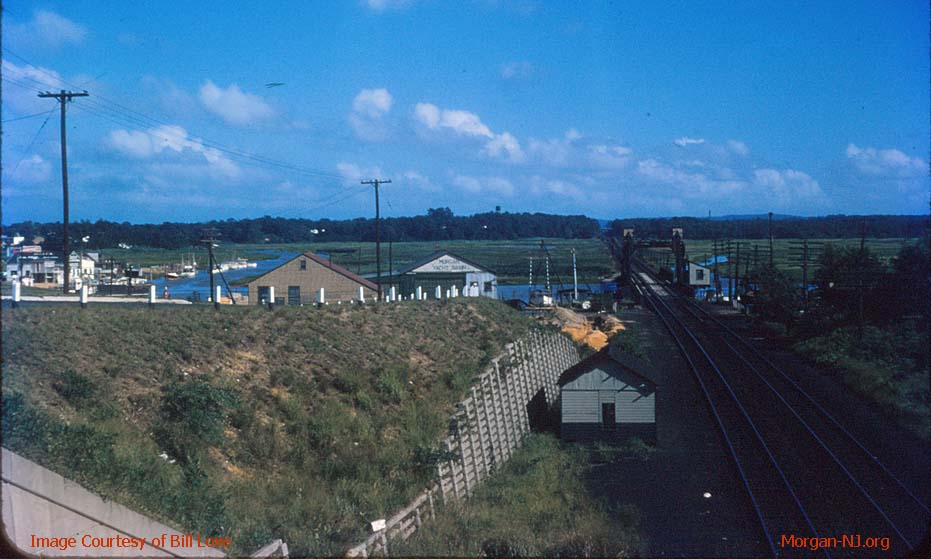
Morgan Station looking from Route 35 toward Cheesequake Creek circa mid-1950s. Image courtesy of Bill Love – BlueChameleon.org.
I was usually the first one up in the morning, and I would wait to see the porch light go off. That meant Grandpa was coming over to have breakfast with me. He left so early to catch the train. He had to be there to put the flag down, we were just a whistle stop, and so if the flag wasn’t down, it [the train] just flew by. On the way home, if you wanted to get off at Morgan Station, you had to yank on the cord just under the hat shelf to make the whistle blow, telling the engineer to stop, someone wants to get off. If by chance you nodded off or were in conversation with your seatmate, you could easily pass your stop.
One rainy winter night, my Grandmother decided to walk over to meet the train with a big black umbrella and a pair of “rubbers” to put over my grandfather’s brand new shoes. She asked me to keep her company. It was a relatively short walk, just across the highway and a couple of hundred yards to the tracks. It was cold. We waited. The 6:10 is always on time. We could hear it approaching. We waited. No whistle! Had he missed the train in Newark? The roar of the approaching train got louder. It had to slow down for that curve around the cliff. Here it comes and leaning against the window, fast asleep, was Grandpa!
We had no cell phones in those days – we just had to wait. We went back to wait. About an hour later we got the call – he slept till the end of the line. He was in Long Branch in a phone booth getting ready to take the ride back!!
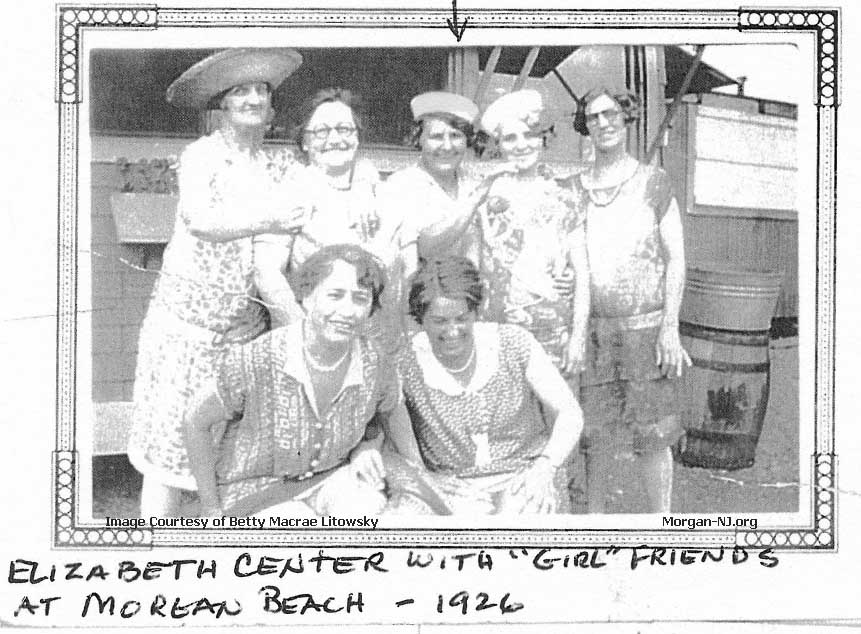
Ladies on Morgan Beach, including Betty’s paternal grandmother, Elizabeth Geldhauser (center top), in 1926. Image courtesy of Betty Macrae Litowsky.
Needless to say, “Nanna,” [i.e., Betty’s paternal grandmother, Elizabeth Geldhauser] was madder than a wet hen. When he finally got back, he was very contrite. It took a couple of weeks before we could tell the story without Nanna “hanging a long face.” Grandma, on the other hand, seemed to enjoy the comical way my father would imitate all the actions of the participants in the tale of woe!
Somewhere in the late fall of ’43 [the middle year of World War II for the US], I was almost 6. It was a weekend and we were still staying on the beach in the bungalow at #10. My sister for some reason stayed back at the [Robert E. Lee] Inn and Nanna and I were listening to the radio shows while she crocheted and I played with my paper dolls. Grandpa had gotten home without incident and had promptly fallen asleep on the little built-in daybed under the window.
There was an air-raid [drill] that night and Uncle Bill was in his glory, with his white “helmet,” and his omnipresent whistle. There were very few holdouts on the beach, especially at our end, but we pulled down the blackout curtains and turned off all the lights except the small lamp next to Nanna’s chair. We waited for the all clear sign. Sometimes the wardens did not sound the all-clear for a long time. This time it was quick. We returned to our radio show and chit-chatted during the commercials (YES, we had commercials in 1943).
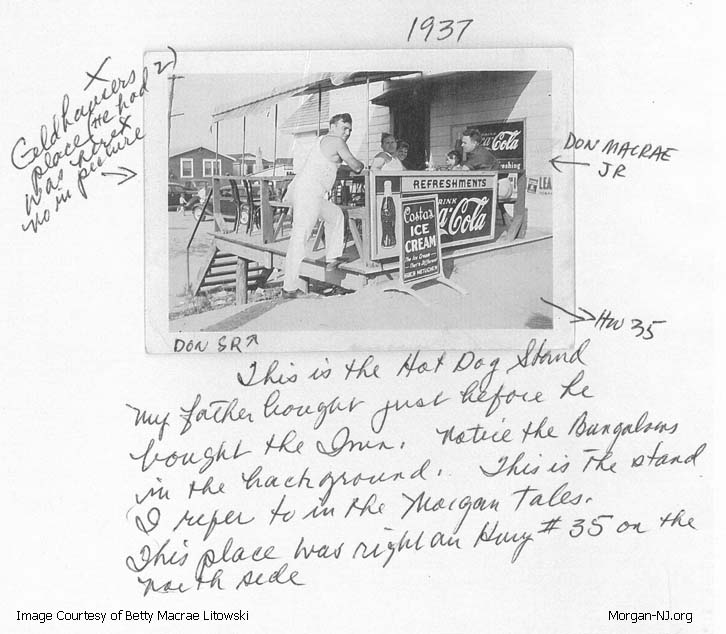
Hand notated photo of Don Macrae, Jr.’s Hot Dog Shack on Morgan Beach in 1937. Image courtesy of Betty Macrae Litowsky.
Around 10:00 pm (my weekend curfew), we decided to have a “midnight” snack (anytime we ate something two or more hours after dinner, it was referred to as a midnight snack). We started putting our things away, and Nanna asked me if I smelled anything strange. “No, not really,” I replied. She began sniffing everywhere – around the sink, around the icebox, then over in the side cupboards when suddenly she said “That’s gas! We have to get out of here right away – go wake Grandpa!”
Now I have mentioned before how low key and laid back Grandpa was but in an emergency, that is not always so good! I ran back to wake him, and he was not waking up. I started to yell his name and he sat right up. When I said we had to leave, he did not question why, he just reached for his tie and began putting it neatly around his neck. Nanna came flying in, “Don, this is an emergency! Forget the tie! Let’s get out of here!”
We got outside and it began to snow. When the cold air hit, both Nanna and Grandpa began to stumble and were both incoherent. Grandpa sat down on the wooden bench, and Nanna, mumbling like a drunk kept saying, “Uncle Bill, Uncle Bill.” She was hanging on me and I couldn’t walk. I told her I would go and get him. Just then she crumbled over and folded like a piece of cardboard! Uncle Bill’s was 5 or 6 cabins down. It seemed so far away! I got to his door and banged as hard as I could! I told him Nanna fell down and Grandpa was on the bench. I told him we smelled gas.
He called the first aid squad and ran down to where his sister and brother-in-law were. He told me to stand away from the house – he thought it might explode! The ambulance came and took my grandmother to the hospital in South Amboy. Uncle Bill took me and Grandpa in his car. I was starting to get a headache. Grandpa was moaning. Nanna and Grandpa both stayed at the hospital and Uncle Bill took me home to my parents.
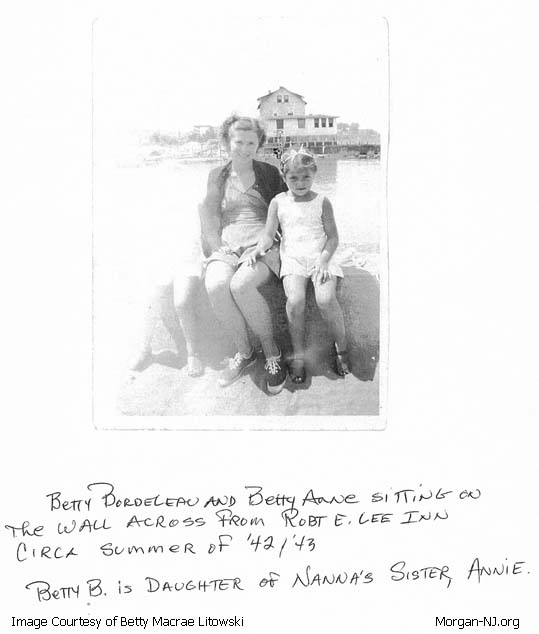
Cousins Betty Bordeleau and Betty Anne Macrae sitting on the wall on Cheesequake Creek Channel across from the Robert E Lee Inn, circa summer of 1943 or 1944. Image courtesy of Betty Macrae Litowsky.
We stayed up all night. My father had to notify the gas company of the leak and the doctors told them not to let me fall asleep for a few hours – why I’m not sure but I was more than willing – I loved the excitement! Nanna was hit the worst, probably because of her excess sniffing, right near the pipes behind the sink. Anyway, her tongue swelled up twice its size and she wasn’t right for a week! Grandpa couldn’t remember anything afterward, and for a while, I couldn’t think or talk about anything else!
When they wrote it up in the newspaper, they called me brave – I loved that! As it turned out, the “leak” occurred because we were the only cabin on that end of the beach with heat. The gas sought the line of least resistance and we were it! This incident became the subject of many conversations for months!
Many people had their own individual pets which were kept on leashes or in their owner’s homes. Our own personal dog was “Skeeter Bum.” He was a pedigreed fox terrier. He was born on my birthday.
Morgan Beach had two “community pets,” a dog and a cat. Unlike most other little towns, we had a brown dog, which looked pretty much like a German Shepherd but with a much wider (and cuter) face. He was always hanging around, was very friendly, and he especially liked children. He would wander over to some stranger’s picnic basket and cuddle up to one of the kids in the group, and presto! He had made another friend and gotten some lunch while he was at it.
No one could own “Brownie.” He was his own man! Some had tried but come morning, he was down at the beach waiting for the crowds to arrive. The beach was the perfect home for him. He loved to swim – throw anything toward the bay and he was in the water, swimming toward whatever it was if it floated, or if it went down, he dove in right where it landed and came up with it in his mouth. A ball, a stick – anything! Sometimes children, in their play, would splash around and scream. If they did, he would “save” them. Many times he jumped into the water to pull in a floundering child who was playing too far out or, a few times, it was a child in real trouble that no one had noticed. He was called “Hero” more than once!
The Beach was also home to a “community” cat. Her name was “Minnie”. She was gray with a white chest and four white paws. She also had some distinctive white markings on her face. She was prolific! At least twice a year (many times more often), she would present us with a litter of kittens. They were a variety from soup to nuts. Sometimes all five (or six) would be completely different! One white, one black, one calico, one tiger – take your pick! She chose our bungalow most times for her “nest” probably because we were there most of the year and there was heat in the cold weather but, also, our place was built up higher than most, so it may have been easier for her to get in and out.
Anyway, for as far back as I can remember, Minnie was at the beach, and when I was a teenager, years later having moved from the Robert E. Lee (and the beach), she was still there, a little worse for the wear but still waddling around. I suppose in today’s world, the animal control warden would be called, and a wealth of love and trust just interacting with these animals would be lost.
Many times, over the years, I’ve thought of those days, and how those beloved “community” pets wove the lives of everyone on that beach together into a tapestry of neighbors and friends.
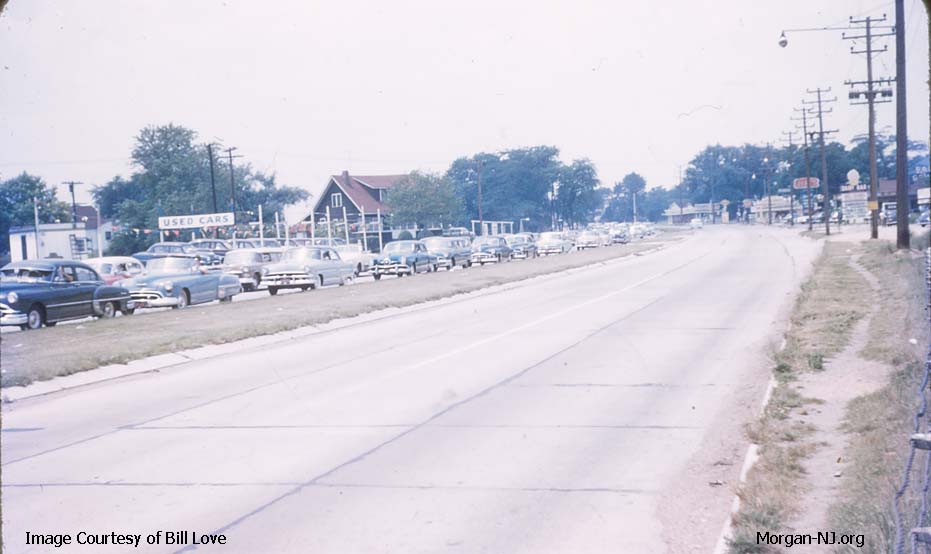
Southbound lanes of State Highway Route 35 waiting for Morgan Bridge to close during the mid-1950’s. Image courtesy of Bill Love – BlueChameleon.org.
With today’s roads and freeways, it is hard to imagine the kind of traffic that was crowded onto the only road the led to the “Jersey Shore”, Highway #35. It was just a single paved lane going south and another going north with soft grassy shoulders on both sides. Vendors sold cold drinks and ice cream set on “dry ice’ in their ice chests (mostly on wheels so that they could be pushed to different locations). Starting around the 4th of July each year, the crowds would really come in full force. By that time we would be shipped over to Morgan Beach to stay with Nanna and Grandpa. It was a pretty idyllic life for a little kid right on the beach, plenty of children to play with, the best food (fresh seafood, fresh fruits, and vegetables from the farmer who drove an open truck piled with the sweetest peaches and melons that you could ever wish for). Mornings started for me at sunrise because I slept on the open porch at the back of the house, and when the sun came up, it would shine right in my eyes and the seagulls would start at the first crack of the light on the horizon. That was my alarm clock! Even today, more than 70 years later, when I hear the caw of gulls, I feel Morgan Beach.
Originally posted on September 23, 2018.
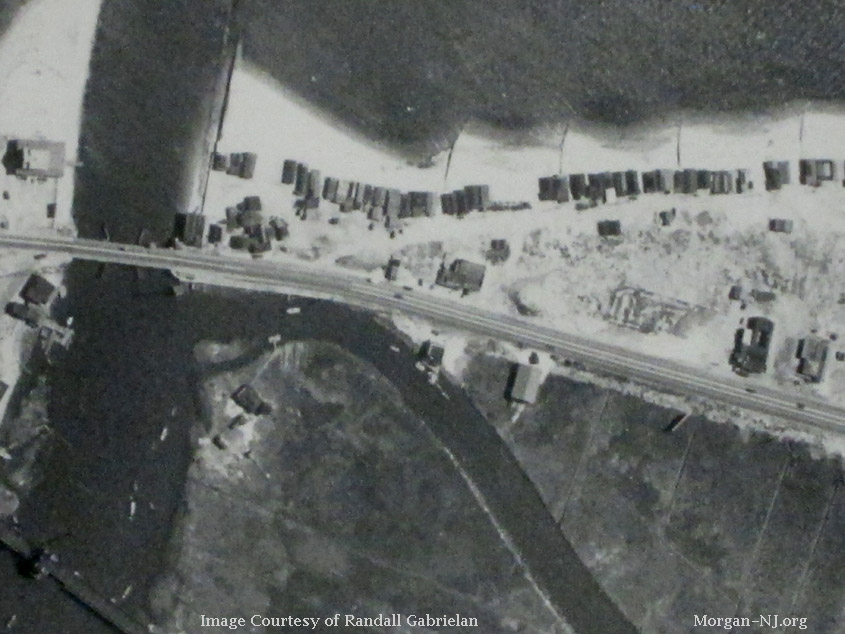

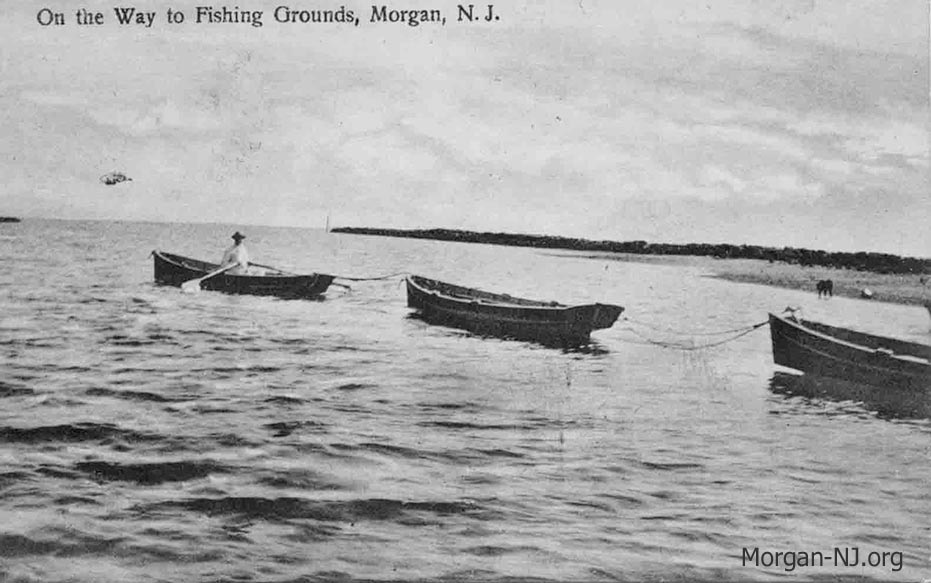
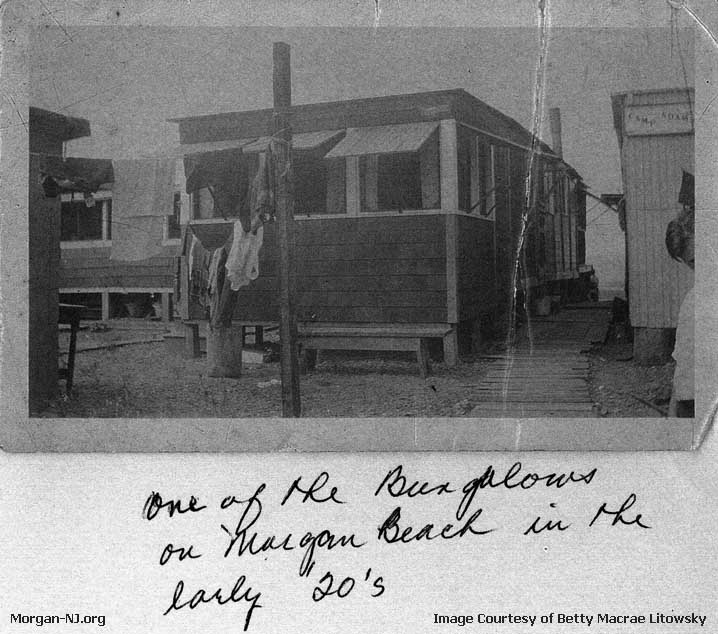
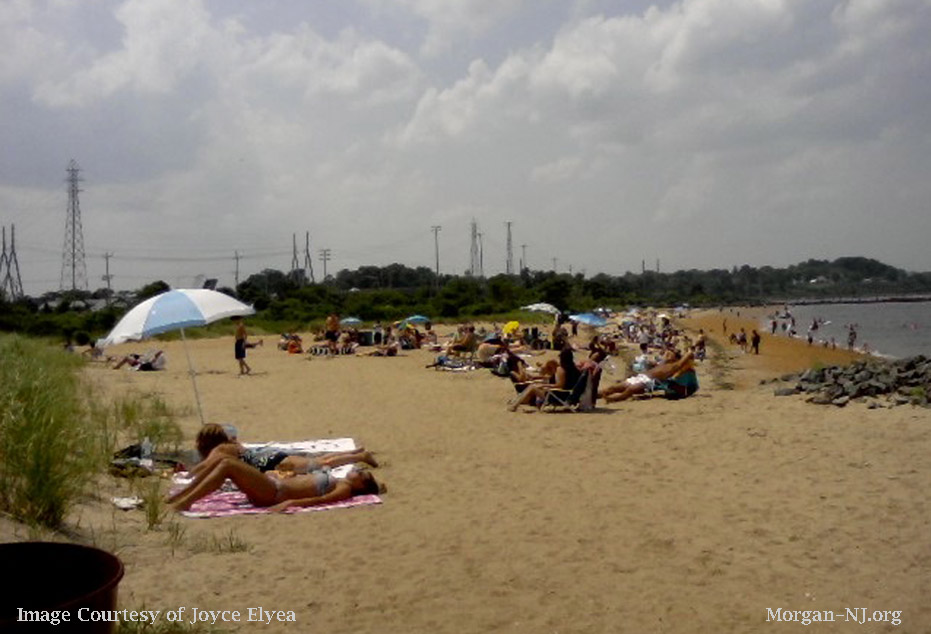
Florence Muth, who I think became Florence MacDonald later in life, was an important person in my teenage years. The grandmother I never had. How wonderful to see a picture of her as a young and vibrant teen herself. Thanks for posting.